An online project under the direction of the CAPE ANN MUSEUM
inv. 43
Brig "Antelope" in Boston Harbor
1863 Oil on canvas 24 1/4 x 36 in. (61.6 x 91.4 cm) Inscribed verso: Painted by F H Lane. / July 1863
|
Supplementary Images
Explore catalog entries by keywords view all keywords »
Historical Materials
Below is historical information related to the Lane work above. To see complete information on a subject on the Historical Materials page, click on the subject name (in bold and underlined).
Book
Other Merchants and Sea Captains of Old Boston, Boston: State Street Trust Company
private collection
Filed under: "Antelope" (Brig) » // Dumaresq, Philip »
9 x 14 in.
Cape Ann Museum Library & Archive
Showing Lane's neighborhood while working in Boston. Lane had studios at the intersection of Washington and State Streets, Summer, Tremont and School Streets.
Also filed under: Lane & Scott's, Lith. – Boston » // Maps » // Professional » // Residences » // Tremont Temple »
Map insert to Boston Almanac and Directory
Cape Ann Museum Library & Archive
Also filed under: Maps » // Residences » // Tremont Temple »
Printed map inside Boston Almanac
Published by B. B. Mussey & Co. and Thomas Groom, Boston
Cape Ann Museum Library & Archive (R910.45 B65 1848)
Map at front of almanac with Tremont Temple highlighted.
Also filed under: Boston Harbor » // Maps » // Tremont Temple »
Boston
Boston Public Library: Norman B. Leventhal Map Center
Call Number: G3764.B6 1852.M35
Also filed under: Maps » // Residences »
During the years after the war of 1812 and before the Civil War, the port of Boston was a center of American deep-water shipping. Trading with China, India, and the West Indies, which had fueled maritime growth in the early years of the century gave way to re-exporting these goods and foreign trade based on the shoe and textile trades. Although second to New York in terms of shipping tonnage, many of New York's shipbuilders and merchants were Boston based. In addition, ship building continued in Boston. Also, the coastal trade (the domestic trade up and down the coast) was still the most efficient way to transport goods and passengers, and accounts for much of the tonnage and shipping traffic.
Although dwarfed by New York, Boston was an active port in the 1840s and 1850s. Its registered tonnage rose from 149,186 in 1840 to 270,510 in 1850. The harbor was a crowded place. For example, on September 18, 1850, 32 ships, 49 barks, 47 brigs, and 52 schooners were reported at Boston.(1)
In 1849, foreign entries at Boston included 215 ships, 305 barks, 908 brigs, and 52 schooners. Coastwise arrivals included 193 ships, 488 barks, 1087 brigs, 4287 schooners, 89 sloops, and 65 schooners.(2)
(1) W.H. Bunting, p.8.
(2) Ibid.
For more information:
Samuel Eliot Morrison, The Maritime History of Massachusetts, 1783-1860
W.H. Bunting, Portrait of a Port, Boston 1852-1914 Cambridge: The Belknap Press of Harvard University, 1971.
Printed map inside Boston Almanac
Published by B. B. Mussey & Co. and Thomas Groom, Boston
Cape Ann Museum Library & Archive (R910.45 B65 1848)
Map at front of almanac with Tremont Temple highlighted.
Also filed under: Boston City Views » // Maps » // Tremont Temple »
Harvard Depository: Widener (NAV 578.57)
For digitized version, click here.
Also filed under: Signal Systems (Flags & Maritime Codes) »
Tinted lithograph with hand coloring
13 7/8 x 22 3/8 in.
Boston Athenaeum
From Sally Pierce and Catharina Slautterback, Boston Lithography, 1825–1880: The Boston Atheneaum Collection (Boston: Athenaeum, 1991): "Tidd drew this print when he was a consulting engineer for Simpson's. He has depicted the clipper ship 'Southern Cross' in the dry dock. Built in 1851, she was known for having sailed from San Francisco to Hong Kong in the record breaking time of thirty-two days. The Bethlehem Ship Building Company eventually took over this location and operated a dry dock there until the mid 1940s."
Also filed under: "Southern Cross" (Clipper Ship) » // M. M. Tidd, Lith. – Boston »
Library of Congress Catalog Number 2004671768
Also filed under: "Britannia" (Cunard Steamship) »
1853
Bostonian Society (1884.0209)
Also filed under: Scott, John W. A. »
1 print : lithograph, tinted ; image 50.3 x 111.9 cm., 68.7 x 121.2 cm.
View of the city of Boston from East Boston showing Boston Harbor. The wharves of East Boston can be seen in the foreground.
Number nine of thirty-eight city views published in "Whitefield's Original Views of (North) American Cities (Scenery).
On stone by Charles W. Burton after a drawing by Edwin Whitefield.
Inscribed in brown ink lower right corner of sheet: "Boston Athenaeum from Josiah Quincy. September 28, 1848."
Local Notes:#1848.1.
The "new" State House is located across from the Boston Common on the top of Beacon Hill, and serves as the Massachusetts state capital. The land was once owned by Massachusetts's first elected governor, John Hancock. Charles Bullfinch was the architect of the building, which was completed in 1798.
The dome was originally roofed with wood shingles, which leaked. In 1802 it was covered with copper by Paul Revere's Revere Copper Company. The dome was first painted gray and then light yellow before being gilded with gold leaf in 1874.
lithograph
1832
"Salmon pinxt" at lower left; "Pendleton, Boston" at lower right
Also filed under: Pendleton's, Lith. – Boston » // Salmon, Robert »
Lithograph
Published by N. Currier, New York
Library of Congress Catalog Number 2002698122
Also filed under: Currier (& Ives) – New York »
The brig "Antelope," 370 tons, was built at East Boston by Samuel Hall in 1843 for Russell and Co. of Boston. She was used in the opium trade with China. She was very fast, enabling owners to have extensive control over the opium trade. This painting, made by Lane in 1863, twenty years after "Antelope's" launch, is apparently based on an earlier, contemporary painting. (1) The "Antelope" was built under his supervision for Russell & Co., in which he was then a partner. (2)
Another ship with the same name, a propeller steamer Steam demi bark Antelope, 615 tons, c.1855 (inv. 449), was built in 1855, also for Russell & Co., for then-opening trade with Japan.
– Erik Ronnberg
References:
1. Some Ships of the Clipper Ship Era (Boston: State Street Trust Co., 1913), 12.
2. R.B. Forbes, Personal Reminiscences (Boston: Little, Brown & Co., 3rd. ed., rev. 1892), 211, 383, also "list of vessels and business partners."
Book
Other Merchants and Sea Captains of Old Boston, Boston: State Street Trust Company
private collection
Also filed under: Dumaresq, Philip »
In general, brigs were small to medium size merchant vessels, generally ranging between 80 and 120 feet in hull length. Their hull forms ranged from sharp-ended (for greater speed; see Brig "Antelope" in Boston Harbor, 1863 (inv. 43)) to “kettle-bottom” (a contemporary term for full-ended with wide hull bottom for maximum cargo capacity; see Ships in Ice off Ten Pound Island, Gloucester, 1850s (inv. 44) and Boston Harbor, c.1850 (inv. 48)). The former were widely used in the packet trade (coastwise or transoceanic); the latter were bulk-carriers designed for long passages on regular routes. (1) This rig was favored by Gloucester merchants in the Surinam Trade, which led to vessels so-rigged being referred to by recent historians as Surinam brigs (see Brig "Cadet" in Gloucester Harbor, late 1840s (inv. 13) and Gloucester Harbor at Dusk, c.1852 (inv. 563)). (2)
Brigs are two-masted square-rigged vessels which fall into three categories:
Full-rigged brigs—simply called brigs—were fully square-rigged on both masts. A sub-type—called a snow—had a trysail mast on the aft side of the lower main mast, on which the spanker, with its gaff and boom, was set. (3)
Brigantines were square-rigged on the fore mast, but set only square topsails on the main mast. This type was rarely seen in America in Lane’s time, but was still used for some naval vessels and European merchant vessels. The term is commonly misapplied to hermaphrodite brigs. (4)
Hermaphrodite brigs—more commonly called half-brigs by American seamen and merchants—were square-rigged only on the fore mast, the main mast being rigged with a spanker and a gaff-topsail. Staysails were often set between the fore and main masts, there being no gaff-rigged sail on the fore mast.
– Erik Ronnberg
References:
1. Howard I. Chapelle, The National Watercraft Collection (Washington, DC: Smithsonian Institution, 1960), 64–68.
2. Alfred Mansfield Brooks, Gloucester Recollected: A Familiar History (Gloucester, MA: Peter Smith, 1974), 62–74. A candid and witty view of Gloucester’s Surinam Trade, which employed brigs and barks.
3. R[ichard] H[enry] Dana, Jr., The Seaman's Friend (Boston: Thomas Groom & Co., 1841. 13th ed., 1873), 100 and Plate 4 and captions; and M.H. Parry, et al., Aak to Zumbra: A Dictionary of the World's Watercraft (Newport News, VA: The Mariners’ Museum, 2000), 95.
4. Parry, 95, see Definition 1.
Oil on canvas
17 1/4 x 25 3/4 in.
Cape Ann Museum, Gloucester, Mass., Gift of Isabel Babson Lane, 1946 (1147.a)
Photo: Cape Ann Museum
Detail of brig "Cadet."
Also filed under: "Cadet" (Brig) »
Painting on board
72 x 48 in.
Collection of Erik Ronnberg
Chart showing the voyage of the brig Cadet to Surinam and return, March 10–June 11, 1840.
Also filed under: "Cadet" (Brig) » // Surinam Trade »
The Whitehall Boat, like the yawl boat, is an early nineteenth-century refinement of an earlier ship's boat type—very likely the gigs of warships. Builders of the earliest examples are believed to have been former navy shipyard employees whose knowledge was put to use building similar boats in their shops on Whitehall Street in lower Manhattan. Recognized as a distinct small boat type in the 1830s, by mid-nineteenth century the Whitehall Boat was in use in most American seaports. (1)
Lane depicted Whitehall Boats in a number of his paintings of major ports, including New York Harbor, c.1855 (inv. 46) (right center foreground), which shows a large example, rowed by four men witha single passenger in the stern, illustrating one of its chief uses as a water taxi. These craft were also used by ship chandlers to deliver ship supplies, and most notoriously by "crimps" who used them to deliver drunken seamen to outbound ships needing crews. Not intended for use in open sea, their light yet strong construction, fine lines, and maneuverability made them ideal for in-harbor work. (2)
Other Whitehall boats appear in the foregrounds of Boston and other unidentified major port scenes (see New England Harbor at Sunrise, c.1850 (inv. 27), Brig "Antelope" in Boston Harbor, 1863 (inv. 43), The "Britannia" Entering Boston Harbor, 1848 (inv. 49), Boston Harbor, Sunset, 1850–55 (inv. 242), The "Constitution" in Boston Harbor, c.1848–49 (inv. 243), and Clipper Ship "Southern Cross" in Boston Harbor, 1851 (inv. 253)).
References:
1. Howard I. Chapelle, American Small Sailing Craft (New York: W.W. Norton & Co., 1951), 195–96.
2. Ibid., 196–99.
Oil on canvas
36 x 60 1/4 in.
Museum of Fine Arts, Boston, Gift of Maxim Karolik for the M. and M. Karolik Collection of American Paintings, 1815–65 (48.446)
Detail of Whitehall boat.
Also filed under: New York Harbor »
The ensign of the United States refers to the flag of the United States when used as a maritime flag to indentify nationality. As required on entering port, a vessel would fly her own ensign at the stern, but a conventional token of respect to the host country would be to fly the flag of the host country (the United States in Boston Harbor, for example) at the foremast. See The "Britannia" Entering Boston Harbor, 1848 (inv. 49) for an example of a ship doing this. The American ensign often had the stars in the canton arranged in a circle with one large star in the center; an alternative on merchant ensigns was star-shaped constellation. In times of distress a ship would fly the ensign upside down, as can be seen in Wreck of the Roma, 1846 (inv. 250).
The use of flags on vessels is different from the use of flags on land. The importance and history of the flagpole in Fresh Water Cove in Gloucester is still being studied.
The modern meaning of the flag was forged in December 1860, when Major Robert Anderson moved the U.S. garrison from Fort Moultrie to Fort Sumter in Charleston Harbor. Adam Goodheart argues this was the opening move of the American Civil War, and the flag was used throughout northern states to symbolize American nationalism and rejection of secessionism.
Before that day, the flag had served mostly as a military ensign or a convenient marking of American territory, flown from forts, embassies, and ships, and displayed on special occasions like American Independence day. But in the weeks after Major Anderson's surprising stand, it became something different. Suddenly the Stars and Stripes flew—as it does today, and especially as it did after the September 11 attacks in 2001—from houses, from storefronts, from churches; above the village greens and college quads. For the first time American flags were mass-produced rather than individually stitched and even so, manufacturers could not keep up with demand. As the long winter of 1861 turned into spring, that old flag meant something new. The abstraction of the Union cause was transfigured into a physical thing: strips of cloth that millions of people would fight for, and many thousands die for.
– Adam Goodheart, Prologue of 1861: The Civil War Awakening (2011).
Stereograph card
Cape Ann Museum Library & Archive
A view of a Cove on the western side of Gloucester Harbor, with the landing at Brookbank. Houses are seen in the woods back. A boat with two men is in the foreground.
Also filed under: Brookbank » // Fresh Water Cove » // Historic Photographs »
Courtesy American Antiquarian Society, Worcester, Mass. (CL.F9116.011.1854 CL.F9116.011.1854)
Also filed under: Oak Hall »
Courtesy American Antiquarian Society, Worcester, Mass. (CL.F9116.011.1854)
Also filed under: Oak Hall »
The use of signal flags, for ship-to-ship communication, generally preceded land-based chains of maritime semaphore stations, the latter using flags or rotating arms, until the advent of the electric or magnetic telegraph.
Until the end of the Napoleonic wars, merchant ships generally sailed in convoy as ordered by the escorting warship(s) using a few simple flags. Peace brought independent voyaging, the end of the convoy system, and the realization by various authorities that merchant vessels now needed their own separate means of signaling to each other. This resulted in a handful of rival codes, each with its individual flags and syntax. In general, they each had a section enabling ship identification and also a "vocabulary" section for transmitting selected messages. It was not until 1857 that a common Commercial Code became available for international use, only gradually replacing the earlier ones. All existed side by side for a decade or two.
Signal systems for American ships were originally intended to identify a vessel by name and owner; only later were more advanced systems developed to convey messages. Most basic were private signals, or "house flags", each of a different design or pattern, identifying the vessel's owner; identification charts were local and poorly distributed, limiting their usefulness. A secondary signal, a flag or large pennant bearing the vessel's name, was sometimes flown by larger ships, but pictorial records of them are uncommon. These private signal flags usually flew from the foremasthead or main masthead if a three master ship. Pilot boats had their own identifying flags, blue and white as seen in Spitfire Entering Boston Harbor (inv. 536). Small vessels, such as schooners, often had a "tell-tale" pennant, an often-unmarked and often red flag, that was used to determine wind direction.
A numerical code flag system, identifying vessels by the code numbers, was introduced by Captain Frederick Marryat R.N. in 1817 for English vessels. American vessels soon adopted this system. Elford's "marine telegraphic system" was the first American equivalent to the Marryat code flags, first issued in 1823, and with changes, remaining in use until the late 1850s. Most of the signal flags on vessels depicted by Lane use Elford's; Brig "Antelope" in Boston Harbor, 1863 (inv. 43) is a noteworthy example of his depiction of Marryat's. The Elford's Code was popular in America on account of its simplicity and only required six blue and white flags. Eventually these changed to red and white, although it is unclear exactly when this happened. Instructions and a key ot the Elford's Code's use are included in successive editions of the Boston Harbor Signal Book.
Whereas the other codes employ at least ten flags of diverse shapes and colours, there are only six Elford flags in total, representing the numbers one to six. All are uniformly rectangular and monochrome in colour (either blue and white or red and white—or even black and white as in an early photograph). Selected from these six flags each individual vessel is allotted a combination of four flags to be prominently displayed as a vertical hoist. Reading from above down these convey its "designated number." Armed with this number and the type of vessel (e.g. ship, bark, brig, schooner /or steamer) the subject can be uniquely identified by reference to a copy of the Boston Harbor Signal Book for the appropriate year.
– A. Sam Davidson
As reproduced in Yankee Sailing Ship Cards by Allan Forbes and Ralph M. Eastman (Boston: State Street Trust Company, 1948).
Also filed under: "Eastern Star" (Bark) » // Forbes, Robert Bennet »
Harvard Depository: Widener (NAV 578.57)
For digitized version, click here.
Also filed under: Boston Harbor »
Boston: Eastburn's Press
New York Public Library
Complete book is included in Google Books, click here.
In The American Neptune 3, no. 3 (July 1943): 205–21.
Peabody Essex Museum
Descriptions of Marryat, Elford, Rogers, and commercial code signal systems, and private signals. Includes illustrations of flag systems with color keys.
Vessel ornamentation assumed two forms: carvings and color schemes. Carvings, or "ship carvings," as they are called by maritime scholars, are usually crafted in wood and painted or gilt. Many vessels were too small or their owners too frugal to permit carved embellishments, in which cases the enhancement of the vessel's color scheme was a practical alternative. This can be seen in many of the coastal vessels along the new England coast. Pinkies and Chebacco boats had handsome color schemes using only black and green with white sheer lines and limited use of red and yellow. Other combinations of inexpensive pigments were used to improve the simple looks of sloops and schooners in the packet trade, while small pleasure craft and pilot schooners enhanced their appearance in similar ways. Clipper ship owners, finding their vessels' appearance impressive without adding color, settled for unrelieved black hulls. Naval vessels as well preserved their formidable looks with black, relieved only with a white belt in way of the gunports.
The more elaborate ship carvings can be classified in the following categories:
Billetheads: mounted on the bow, at the end of a simple gammon knee, or on the forward end of an elaborate stem-head, they can be scrolls of less or greater intricacy, or sometimes the heads of animals, eagles being the most common. Examples of a sea serpent's head, a pointing hand, and other animal heads have been found. (See Brig "Cadet" in Gloucester Harbor, late 1840s (inv. 13); Brig "Antelope" in Boston Harbor, 1863 (inv. 43); and Brig Off the Maine Coast, 1851 (inv. 241))
Figureheads: mounted on bows of larger vessels, often with elaborate stem joinerwork (trailboards and headboards with associated knees and rails). Usually these were full-length figures representing the ship's owner, a famous citizen, a mythological person or animal, or an eagle. (See Portrait of the "National Eagle", 1853 (inv. 35) (eagle); New York Harbor, c.1855 (inv. 46); The "Britannia" Entering Boston Harbor, 1848 (inv. 49) (female figures); The Ships "Winged Arrow" and "Southern Cross" in Boston Harbor, 1853 (inv. 54) (dragon and eagle); "Starlight" in Harbor, c.1855 (inv. 249) (dragon); and Steam demi bark Antelope, 615 tons, c.1855 (inv. 375) (antelope))
Trailboards: carved vines or scrollwork abaft the figurehead which trail aft along the stem head in a graceful descending arc, terminating at the hawse pipes. They are usually gilt and frequently ornamented with carved rosettes and other devices. (See Brig "Cadet" in Gloucester Harbor, late 1840s (inv. 13); Portrait of the "National Eagle", 1853 (inv. 35); Brig "Antelope" in Boston Harbor, 1863 (inv. 43); New York Harbor, c.1855 (inv. 46); and The Ships "Winged Arrow" and "Southern Cross" in Boston Harbor, 1853 (inv. 54))
Headboards: boards mounted to headrails connecting the figurehead to the ship's mainrail at the catheads. While seldom given any decorative carvings, the vessel's nameboards were often mounted to them. (See Brig "Cadet" in Gloucester Harbor, late 1840s (inv. 13); Portrait of the "National Eagle", 1853 (inv. 35); Brig "Antelope" in Boston Harbor, 1863 (inv. 43); The Ships "Winged Arrow" and "Southern Cross" in Boston Harbor, 1853 (inv. 54); Clipper Ship "Southern Cross" in Boston Harbor, 1851 (inv. 253); and Mary Ann, 1846 (inv. 309))
Catheads: Carved lion heads mounted on the outboard ends of the cathead knees. This term is so archaic that the knees and carvings are treated as one and the same, as in their use, i.e. "catting the anchor" (securing the anchor ring to the cathead). (See Brig "Antelope" in Boston Harbor, 1863 (inv. 43); and An American Frigate Hove-to Off the New England Coast (inv. 535))
Quarterboards: Name boards mounted to the vessel's side near the stern, they usually had ornamental edge moldings and sometimes stars or simple scrollwork at each end of the name. (See Portrait of the "National Eagle", 1853 (inv. 35); Mary Ann, 1846 (inv. 309); and Spitfire Entering Boston Harbor (inv. 536))
Transom arches: arch-form panels fitted to the transom, often over gallery lights (windows) or other carvings. They usually have edge moldings, decorative scrollwork, and sometimes a bust or other carved figure at the center.
Other transom carvings: carved eagles, busts, scrollwork and coats of arms can occupy the space between the transom arch and the sternboard. If galleries are present, carved scrollwork may be fitted between the frames of the gallery lights. (See Boston Harbor, c.1850 (inv. 48); The Topsail Schooner "Kamehameha III" in Boston Harbor, 1846 (inv. 301) (eagle); Baltimore Harbor, 1850 (inv. 400) (eagle); and Rough Sea, Schooners, c.1856 (not published) (eagle and flags))
Sternboard: often the bottom plank of the transom on which the vessel's name is carved or painted, seldom with decoration (stars or scrollwork). There is usually simple protective molding above and below the lettering.
Sideboards, or gangway boards: boards on either side of an entry way at main rail level on a large ship, usually between the main and mizen masts. They are carved and painted or (if of fine hardwood) varnished. Most commonly seen on larger vaval vessels, packet ships, and clipper ships.
– Erik Ronnberg
References:
1. Brewington, M. V., Shipcarvers of North America, (Barre, MA: Barre Publishing Co., 1962).
2. The American Neptune, Pictorial Supplement XIX, "The Art of the Shipcarver" (Salem, MA: The Peabody Museum, 1977).
3. Ship Figureheads (Boston: State Street Trust Co., n.d.).
4. Edouard A. Stackpole, Figureheads & Carvings at Mystic Seaport (Mystic, CT: The Marine Historical Association, Inc., 1964).
Carved wood with paint and gilt
12 x 22 x 8 in.
Cape Ann Museum. Gift of George W. Woodbury, 1936 (747)
This sea serpent billet head came from the schooner "Diadem" which was built in Essex, Massachusetts, in 1855 and owned by D. Elwell Woodbury and John H. Welsh of Gloucester.
Sea serpents were reportedly sighted here on Cape Ann from colonial times through the mid-nineteenth century. In 1817, more than 50 people, many of them prominent members of the community, reported seeing a serpent in the waters of Gloucester Harbor just off Pavilion Beach. So credible were the reports that the Linnaean Society of New England collected depositions from witnesses and published their findings in a small pamphlet entitled Report of a Committee of the Linnaean Society of New England relative to a Large Marine Animal Supposed to be A Serpent, seen Near Cape Ann, Massachusetts, in August 1817.
Also filed under: Objects » // Pavilion (Publick) Beach »
Charles Peter Clark was born in Nashua, New Hampshire on August 11, 1836. He was the son of Peter and Susan Lord Clark, and the nephew of Daniel W. Lord. His parents represented the union of two prominent New England families, the Clarks and the Lords of Kennebunkport, Maine.
As a result of a lengthy ocean voyage from 1852 to 1853, undertaken to improve his health, young Charles acquired a liking for the sea and maritime activity. It was not long until he purchased a small vessel and embarked in the West African trade from Boston, employing a captain while accompanying the vessel as its supercargo. He was part operator of the vessel Antelope, depicted twice by Lane, as a colored lithograph: Steam demi-bark Antelope, 615 tons and later as a painting: Brig Antelope in Boston Harbor.
In 1857, Charles P. Clark & Co.,was formed. It was a shipping enterprise that operated vessels in the West African trade. (The venture was dissolved on January 26, 1860). For two and one-half years Clark, evidently in partnership with Theodore E. Goodhue, operated the "Antelope," "Clarinda," and "Somers" on the Boston–West Africa route, carrying dry goods, ironware, flour, lard, and even firearms, to Liberia for palm oil and other items. In February 1862, Clark sold the brig "Somers" to William Ropes & Co., but acted as their agent for the vessel until he entered the Union Navy the following October.
Clark was discharged from the service in 1865 and subsequently spent a short time as a merchant in St. Louis, but he soon returned to Boston and became a partner in a shipping firm.
Clark was hired as a clerk for the Boston, Hartford & Erie Railroad, and thus began a career that would, by 1877, bring him to the presidency of the New York, New Haven & Hartford Railroad Company. He retired in 1899 and died two years later while vacationing in Nice, France.
- Information from Mystic Seaport, where Clark's papers are housed.
Book
Other Merchants and Sea Captains of Old Boston, Boston: State Street Trust Company
private collection
Also filed under: "Antelope" (Brig) »
Robert Bennet Forbes (1804–89) of Boston was a key figure in his family's business in the China trade. While his brothers and cousins took positions as land-based merchants stationed either in Boston or Canton, Robert Bennet Forbes chose life at sea. He went on many trips to China, starting in 1817 as a cabin boy—thirteen years old—and eventually as a ship captain.
Forbes became a partner in the firm in 1832, known by then as Russell & Co., Canton, and went for a two-year trip to China in 1838–40 as a merchant. He was a proponent of steam power, which helped ships on the long voyage to China and Japan, and gave them the speed to evade the pirates who were ever present in the opium trade. His firm built about 70 ships, of which he was owner or part owner of several.
Robert Bennet Forbes also helped to introduce yachting as a sport, and participated in some of the first yacht races. His book Personal Reminiscences, published in 1892, lists many of these exploits, as well as all of the vessels he owned and built.
Forbes was known for his adventurous spirit. In 1846, when news of the Irish famine reached Boston, he convinced the U.S.Navy to lend him the "USS Jamestown" to take food to famine sufferers in 1847. He was the first civilian given the honor of commanding a naval vessel, and he crossed the Atlantic in a record seventeen days. Forbes wrote a book about his trans-Atlantic voyage for which he commissioned Lane to make the frontispiece illustration.
The "Jamestown" commission was one of several works Lane made for Forbes. Forbes was not only adventurous but innovative, and he commissioned Lane to make works after two of his newly designed steam vessels: the "Massachusetts," a packet ship that used steam power to supplement wind power, and the "Antelope," that relied primarily on steam power.
The Forbes family lived in Milton, Massachusetts, and also had a home in Beverly, Massachusetts. In 1856 Forbes bought land in West Manchester and built a summer home there which he christened "Masconomo" after the sagamore, chief of the Agawam.
In 1834 Captain Forbes married Rose Greene Smith. She died September 18, 1885, having borne her husband three children: Robert Bennet Forbes (1837–June 30, 1891); Edith Forbes, who married Charles Eliot Perkins; and James Murray Forbes (b. July 17, 1845). He died on November 23, 1889 in Milton.
As reproduced in Yankee Sailing Ship Cards by Allan Forbes and Ralph M. Eastman (Boston: State Street Trust Company, 1948).
Also filed under: "Eastern Star" (Bark) » // Signal Systems (Flags & Maritime Codes) »
Phillips Library, Peabody Essex Museum
1011.2 F695
Also filed under: "Massachusetts" (Auxiliary Steam Packet Ship) »
vol. 1, no. 1
January 1941
pp. 51-57
Also filed under: "Antelope" (Steam Demi-Bark) » // "Massachusetts" (Auxiliary Steam Packet Ship) »
Typed transcription of photograph caption
Manchester Historical Museum, Manchester, Mass.
Also filed under: Manchester, Mass. »
map
Manchester Historical Museum
Also filed under: Manchester, Mass. »
c. 1857
Manchester Historical Museum
In 1856 Robert Bennet Forbes bought nineteen acres of land for $2,800 from Israel F. Tappan in the section of the West Manchester shore known in those days as Newport. There he built Masconomo, named for the sagamore of the Agawam. In her unpublished letters to her son Robert, his wife Rose Greene Forbes wrote:
"...I think Father will put up a good sized cheap summer house, rough pillars, pine furniture etc., and very likely we shall all be there for two months next summer. He means to show people how rational people ought to live at the seaside. What nice times we shall have..."
The house was sold to Benjamin G. Boardman in 1865.
Also filed under: Manchester, Mass. »
Book "Family Photographs" 1:45
Privately Printed: The Riverside Press
Collection of the Forbes House Museum.
Also filed under: Forbes, John Murray » // Manchester, Mass. »
Book
University Press, John Wilson and Sons, Cambridge, Massachusetts
Second edition, 1882, contains "Rambling Recollections Connected with China." Google book version.
Also filed under: "Massachusetts" (Auxiliary Steam Packet Ship) »
Also filed under: Forbes, John Murray »
Robert Bennet Forbes scrapbook
vol. 1, p. 4
Phillips Library, Peabody Essex Museum (SCR 4)
"SPLENDID NAVAL VICTORY. We have received intelligence by the arrival of the Caledonia of one of the most splendid naval victories ever achieved under the American flag..." This article is a humorous metaphor, comparing Forbes' mission to bring food to the starving Irish to a naval assault on the city of Cork.
Also filed under: "Caledonia" (Cunard Steamship) » // "Jamestown" (U.S. Sloop of War) » // Newspaper / Journal Articles »
Perhaps painted in Canton
Collection of the Forbes House Museum
Given to the Forbes House Museum by H.A. Crosby Forbes, Ph.D., Robert P. Forbes, Ph.D., and Douglas B. Forbes in 2012
The painting was commissioned by Robert Bennet Forbes to commemorate the death of his brother, Thomas Tunno Forbes, in 1829 on "The Haide" during a storm off the coast of Macao.
Collection of the Forbes House Museum, Milton, Mass.
Scene depicts the "Jamestown" being towed out of Charlestown Navy Yard. Plaque reads: "To Captain R. Bennett [sic] Forbes / From his English friends. / The "Jamestown" American Sloop of War as she left Boston under his command / bound to CORK with DONATIONS of FOOD / freight free for the Irish. / 1847."
Also filed under: "Jamestown" (U.S. Sloop of War) »
Boston
Eastburn's Press
Link to Google Books.
Also filed under: "Jamestown" (U.S. Sloop of War) » // Lane & Scott's, Lith. – Boston » // Professional »
16 1/2 x 20 1/2 in., on sheet 18 1/8 x 22 1/2 in.
Courtesy American Antiquarian Society, Worcester, Mass.
One of these lithographs was given to R. B. Forbes at an event held on the 19th of April at the Cork Temperance Institute.
"U.S. Sloop of war, Jamestown: Capt. R. B. Forbes. This print, commemorative of the splendid generosity of the American government in dismantling a ship of war for a mission of peace and charity, & of the noble-hearted citizens who humanely & benevolently responded to the call of Irish distress, is respectfully dedicated to the President, House of Representatives, Congress and people of the United States of America, by their obedt. servants, George M. W. Atkinson, William Scraggs, Cove of Cork 13th April, 1847"
Also filed under: "Jamestown" (U.S. Sloop of War) »
Collection of the Forbes House Museum, Milton, Massachusetts
Gift to R. B. Forbes from the U.S. Navy to commemorate voyage of the "Jamestown."
Also filed under: "Jamestown" (U.S. Sloop of War) »
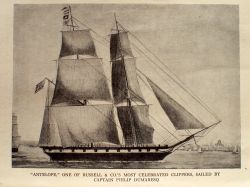
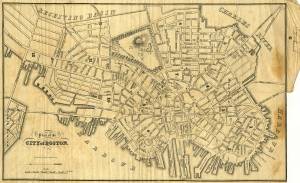
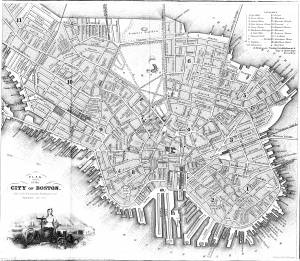
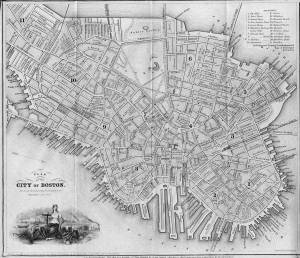
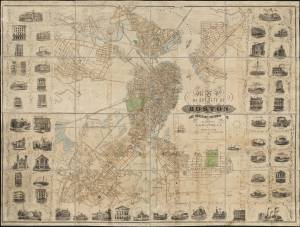
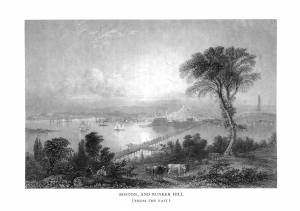

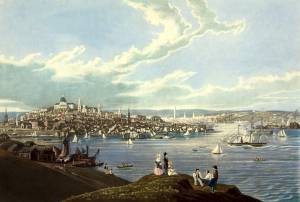
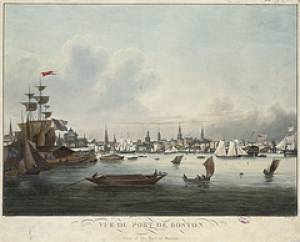

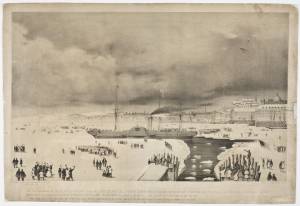

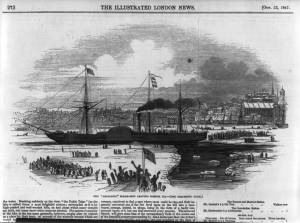

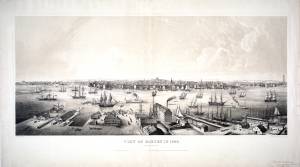


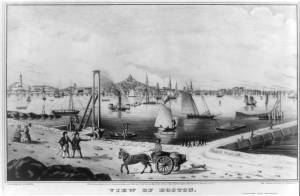
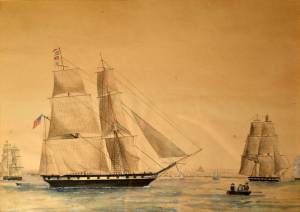
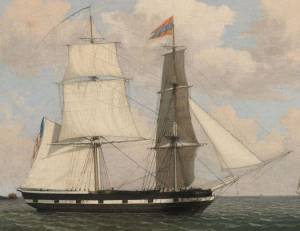

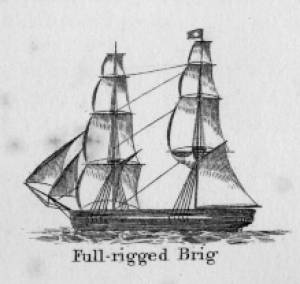


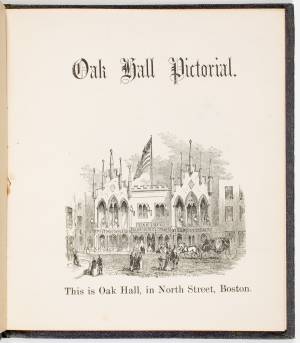
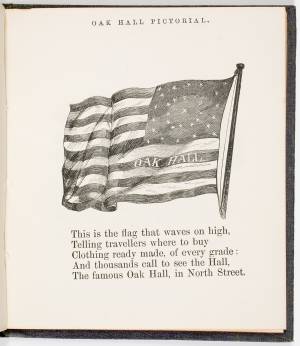



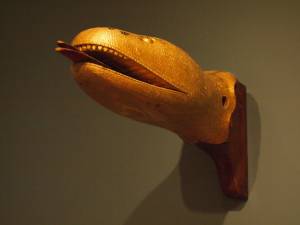



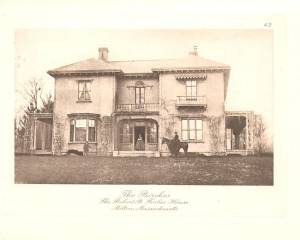
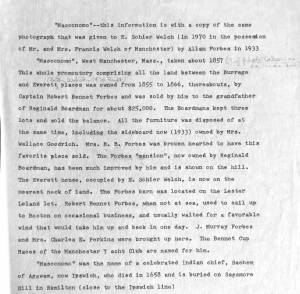
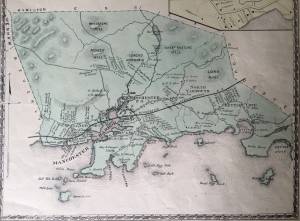
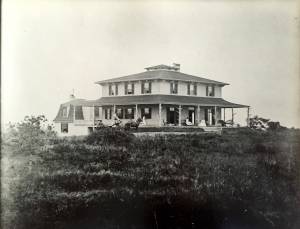
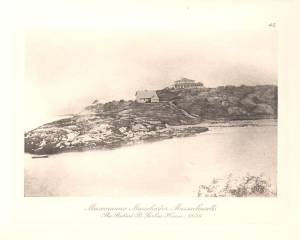
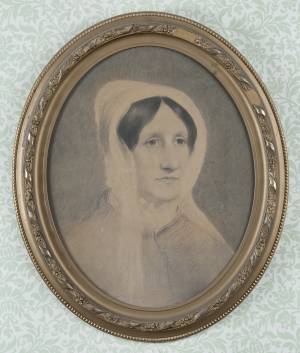


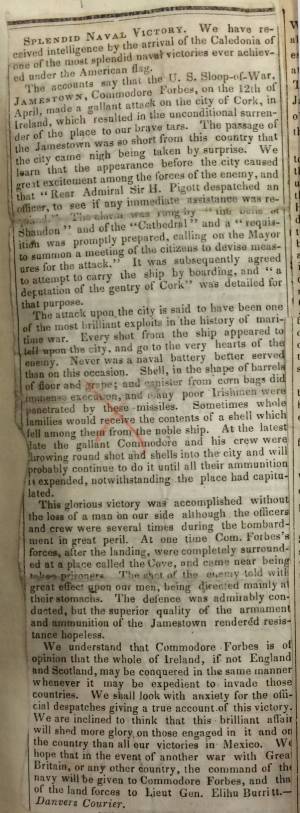
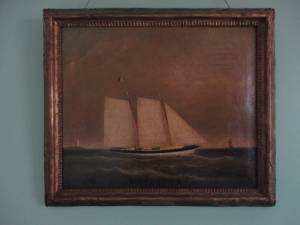
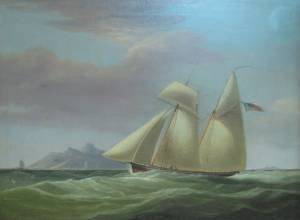

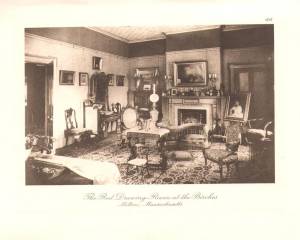



Commentary
The brig "Antelope" was built at East Boston in 1843 by Samuel Hall for the firm of Russell and Co. Robert Bennett Forbes was then a partner in that firm and oversaw the brig’s design and construction. Under the command of Philip Dumaresq, her first captain, the resulting vessel proved to be exceptionally fast. At that time, Dumaresq was regarded as Boston’s most able shipmaster.
Built for the opium trade, "Antelope" left Boston in 1843 and spent her entire career smuggling opium into China. She never returned to her home port. Dismasted in a typhoon in 1848, she was rerigged as a bark but was never as fast as before. She was wrecked on a reef near Wusong, China, in 1852. (1)
The date on Lane’s painting (1863) postdates "Antelope's" departure from Boston by twenty years and her loss by eleven years, suggesting that the painting was commissioned by a relative (perhaps Francis Dumaresq) as a memorial to the vessel and to Captain Dumaresq (d. 1861). The brig’s longtime absence from Boston makes it unlikely that Lane had the opportunity to make sketches, let alone a painting, during her existence. His likeliest source was a painting showing "Antelope" posed with its sails trimmed in just the same way, and in the same location in Boston Harbor. The crude depiction of the Boston skyline in that painting adds to the probability that it is of Chinese origin. (2)
Lane’s version has made clearer this image’s narrative content. "Antelope" is depicted as having just arrived in port (an imagined return from China is presumed). She is hove to off East Boston, with foresails aback and her yawl boat in tow astern, ready to bring the captain ashore to report to the Custom House with ship’s papers and cargo manifest. While conjecture has placed Lane in the yawl boat in right foreground, the facial features—most notably the sideburns—bear a closer resemblance to Captain Dumaresq, reinforcing the argument that this painting is a memorial to both the vessel and her first master. (3)
The Boston skyline is typical of Lane’s depictions of this port, whether from Governor’s Island or, in this case, East Boston. This painting’s panoramic view is bounded by Charlestown and the Navy Yard on the right, and Boston Neck and Fort Point Channel on the left. It is also time specific to the mid-1840s, with towers, steeples, and other prominent structures of later dates omitted.
– Erik Ronnberg
References:
1. Robert Bennett Forbes, Personal Reminiscences (Boston: Little, Brown & Co., 1892), 21, appendix: “List of Vessels."
2. State Street Trust Company, Old Shipping Days in Boston (Boston: State Street Trust, 1913), 12; and State Street Trust Company, Other Merchants and Sea Captains of Old Boston (Boston: State Street Trust, 1919), 21–25.
3. Ibid., 22.
[+] See More